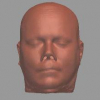Free Online Productivity Tools
i2Speak
i2Symbol
i2OCR
iTex2Img
iWeb2Print
iWeb2Shot
i2Type
iPdf2Split
iPdf2Merge
i2Bopomofo
i2Arabic
i2Style
i2Image
i2PDF
iLatex2Rtf
Sci2ools
CVPR
2007
IEEE
2007
IEEE
Automatic Face Recognition from Skeletal Remains
The ability to determine the identity of a skull found at a crime scene is of critical importance to the law enforcement community. Traditional clay-based methods attempt to reconstruct the face so as to enable identification of the deceased by members of the general public. However, these reconstructions lack consistency from practitioner to practitioner and it has been shown that the human recognition of these reconstructions against a photo gallery of potential victims is little better than chance. In this paper we propose the automation of the reconstruction process. For a given skull, a data-driven 3D generative model of the face is constructed using a database of CT head scans. The reconstruction can be constrained based on prior knowledge such as age and or weight. To determine whether or not these reconstructions have merit, geometric methods for comparing reconstructions against a gallery of facial images are proposed. First, Active Shape Models are used to automatically dete...
Computer Vision | CVPR 2007 | Facial Images | Reconstruction Process | Reconstructions Lack Consistency | Traditional Clay-based Methods | Uses Constrained Optimization |
| Added | 12 Oct 2009 |
| Updated | 28 Oct 2009 |
| Type | Conference |
| Year | 2007 |
| Where | CVPR |
| Authors | Carl Adrian, Nils Krahnstoever, Peter H. Tu, Phil Williams, Rebecca Book, Xiaoming Liu 0002 |
Comments (0)

